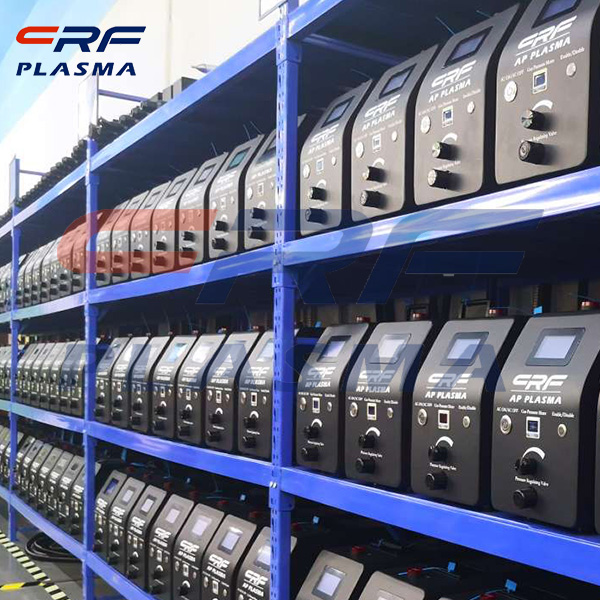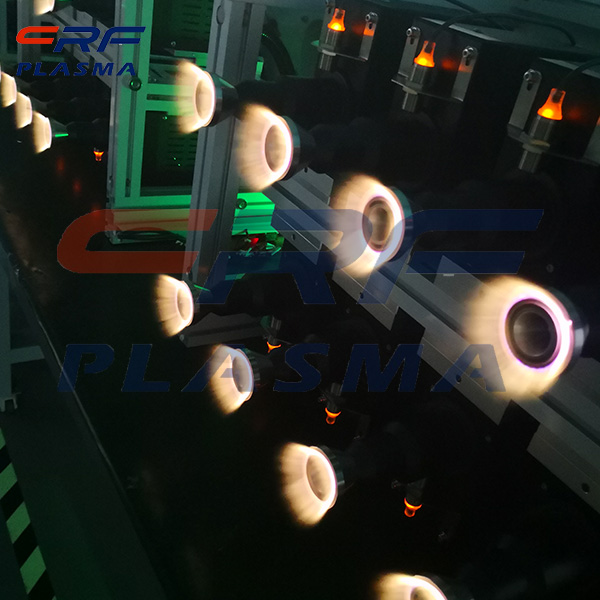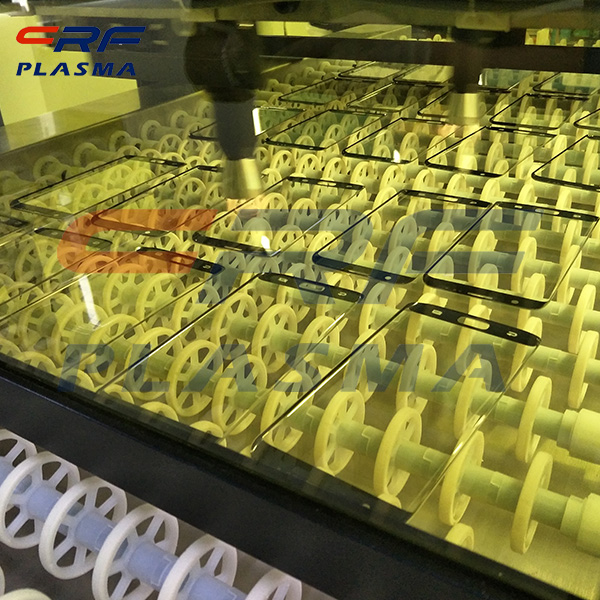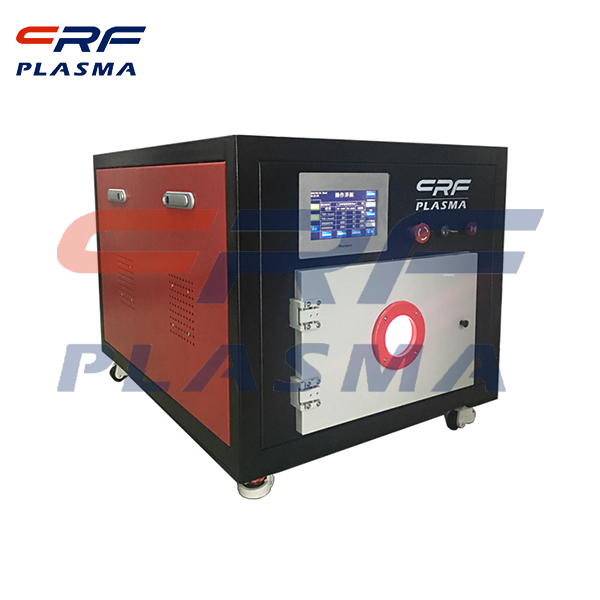
Welcome to Shenzhen Sing Fung Intelligent Manufacturing Co., Ltd.
E-mail:shaobo@sfi-crf.com
The application of plasma cleaning technology in the cleaning treatment of photocathode accessories
- Categories:Company Dynamics
- Author:Plasma cleaning machine-CRF plasma plasma equipment-plasma surface treatment machine manufacturer-chengfeng intelligent manufacturing
- Origin:
- Time of issue:2021-07-16
- Views:
(Summary description)The application of plasma cleaning technology in the cleaning treatment of photocathode accessories: In addition to the super-cleaning function, the plasma cleaner can also change the surface properties of certain materials under certain conditions as needed. Plasma acts on the surface of the material to recombine the chemical bonds of surface molecules and form new surface characteristics. For some special-purpose materials, the glow discharge of the plasma cleaner in the ultra-cleaning process enhances the adhesion, compatibility and wettability of these materials. Therefore, plasma cleaning, as a new type of cleaning technology, will be widely used in the fields of optics, optoelectronics, materials science, biomedicine, microfluidics, etc. Vacuum optoelectronic devices represented by low-light image intensifiers are widely used in national defense, scientific research and other industries, and are highly valued in China. The low-light-level image intensifier uses a photocathode to generate corresponding photoelectron images under the excitation of input photons from the scene, thereby converting weak or invisible radiation images into electronic images. In the ultra-high vacuum tube, the electronic optical system exerts great influence on the photoelectrons. A strong electric field is focused by an electron optical lens (or through a microchannel plate electron multiplying method), bombarding the phosphor screen with high-energy electrons to emit light, realizing the multiple increase of incident light energy, thereby producing the corresponding photon image imaging visible to the human eye Device. The low-light image intensifier is a vacuum photoelectric imaging device. Its production and manufacturing process is complex and diverse. Its production and manufacturing show two major characteristics: ultra-high vacuum, ultra-high cleanliness, especially the removal of hydrocarbons and hydrogen pollution. The stability of it is very important. Therefore, the device has very high cleanliness requirements for parts, accessories and semi-finished components in the process of circulation. Take the auxiliary parts used in the manufacture of photocathodes of image intensifiers: antimony base base and single tube base as examples. These two auxiliary parts are the main tools in the photocathode manufacturing process. The insulation performance of the ceramic terminal directly affects the photocathode. Manufacturing quality of production. The structure of the antimony base seat and the single tube seat is compact, the ceramic terminals are densely distributed, and the groove space at the metal rod is narrow. It is very difficult to scrub with tools. Previously, chemical immersion (RBS cleaning agent) and ultrasonic cleaning methods were used for the antimony base seat and single tube seat with poor insulation performance of the ceramic terminal. These cleaning methods were used to treat the antimony base seat and single tube seat with poor insulation performance of the ceramic terminal. The socket is cleaned. Although the insulation performance of the ceramic terminal of the antimony base has been improved to a certain extent, after a short period of use, excessive leakage current of the ceramic terminal will occur repeatedly, which is manifested as incomplete cleaning. The application of this method of cleaning makes the cleaning frequency of the antimony base seat and the single tube seat too high, and the frequency of use is low. At the same time, the use cost is increased, and the environmental pollution is also increased. Plasma cleaning technology is used to clean antimony base holders and single-tube holders with poor insulation performance of current ceramic terminals. When cleaning with a plasma cleaner, the entire quartz cavity of the plasma cleaner is filled with plasma, and any part of the workpiece, including small grooves, slits, and micropores that cannot be cleaned by ordinary cleaning methods, can be completely The cleanliness. At the same time, the use of plasma cleaning can fundamentally improve the insulation performance of the ceramic terminal, extend the life cycle of the antimony base seat and the single tube seat, improve production efficiency, reduce production costs, and reduce environmental pollution. Fully understand the application of new cleaning technology in the cleaning treatment of photocathode accessories, innovate the original cleaning method, improve the cleaning effect of the image intensifier accessories, and improve the product process yield and work efficiency.
The application of plasma cleaning technology in the cleaning treatment of photocathode accessories
(Summary description)The application of plasma cleaning technology in the cleaning treatment of photocathode accessories:
In addition to the super-cleaning function, the plasma cleaner can also change the surface properties of certain materials under certain conditions as needed. Plasma acts on the surface of the material to recombine the chemical bonds of surface molecules and form new surface characteristics. For some special-purpose materials, the glow discharge of the plasma cleaner in the ultra-cleaning process enhances the adhesion, compatibility and wettability of these materials.
Therefore, plasma cleaning, as a new type of cleaning technology, will be widely used in the fields of optics, optoelectronics, materials science, biomedicine, microfluidics, etc. Vacuum optoelectronic devices represented by low-light image intensifiers are widely used in national defense, scientific research and other industries, and are highly valued in China. The low-light-level image intensifier uses a photocathode to generate corresponding photoelectron images under the excitation of input photons from the scene, thereby converting weak or invisible radiation images into electronic images. In the ultra-high vacuum tube, the electronic optical system exerts great influence on the photoelectrons. A strong electric field is focused by an electron optical lens (or through a microchannel plate electron multiplying method), bombarding the phosphor screen with high-energy electrons to emit light, realizing the multiple increase of incident light energy, thereby producing the corresponding photon image imaging visible to the human eye Device.
The low-light image intensifier is a vacuum photoelectric imaging device. Its production and manufacturing process is complex and diverse. Its production and manufacturing show two major characteristics: ultra-high vacuum, ultra-high cleanliness, especially the removal of hydrocarbons and hydrogen pollution. The stability of it is very important. Therefore, the device has very high cleanliness requirements for parts, accessories and semi-finished components in the process of circulation. Take the auxiliary parts used in the manufacture of photocathodes of image intensifiers: antimony base base and single tube base as examples. These two auxiliary parts are the main tools in the photocathode manufacturing process. The insulation performance of the ceramic terminal directly affects the photocathode. Manufacturing quality of production. The structure of the antimony base seat and the single tube seat is compact, the ceramic terminals are densely distributed, and the groove space at the metal rod is narrow. It is very difficult to scrub with tools.
Previously, chemical immersion (RBS cleaning agent) and ultrasonic cleaning methods were used for the antimony base seat and single tube seat with poor insulation performance of the ceramic terminal. These cleaning methods were used to treat the antimony base seat and single tube seat with poor insulation performance of the ceramic terminal. The socket is cleaned. Although the insulation performance of the ceramic terminal of the antimony base has been improved to a certain extent, after a short period of use, excessive leakage current of the ceramic terminal will occur repeatedly, which is manifested as incomplete cleaning. The application of this method of cleaning makes the cleaning frequency of the antimony base seat and the single tube seat too high, and the frequency of use is low. At the same time, the use cost is increased, and the environmental pollution is also increased. Plasma cleaning technology is used to clean antimony base holders and single-tube holders with poor insulation performance of current ceramic terminals. When cleaning with a plasma cleaner, the entire quartz cavity of the plasma cleaner is filled with plasma, and any part of the workpiece, including small grooves, slits, and micropores that cannot be cleaned by ordinary cleaning methods, can be completely The cleanliness. At the same time, the use of plasma cleaning can fundamentally improve the insulation performance of the ceramic terminal, extend the life cycle of the antimony base seat and the single tube seat, improve production efficiency, reduce production costs, and reduce environmental pollution. Fully understand the application of new cleaning technology in the cleaning treatment of photocathode accessories, innovate the original cleaning method, improve the cleaning effect of the image intensifier accessories, and improve the product process yield and work efficiency.
- Categories:Company Dynamics
- Author:Plasma cleaning machine-CRF plasma plasma equipment-plasma surface treatment machine manufacturer-chengfeng intelligent manufacturing
- Origin:
- Time of issue:2021-07-16 21:46
- Views:
The application of plasma cleaning technology in the cleaning treatment of photocathode accessories:
In addition to the super-cleaning function, the plasma cleaner can also change the surface properties of certain materials under certain conditions as needed. Plasma acts on the surface of the material to recombine the chemical bonds of surface molecules and form new surface characteristics. For some special-purpose materials, the glow discharge of the plasma cleaner in the ultra-cleaning process enhances the adhesion, compatibility and wettability of these materials.
 Therefore, plasma cleaning, as a new type of cleaning technology, will be widely used in the fields of optics, optoelectronics, materials science, biomedicine, microfluidics, etc. Vacuum optoelectronic devices represented by low-light image intensifiers are widely used in national defense, scientific research and other industries, and are highly valued in China. The low-light-level image intensifier uses a photocathode to generate corresponding photoelectron images under the excitation of input photons from the scene, thereby converting weak or invisible radiation images into electronic images. In the ultra-high vacuum tube, the electronic optical system exerts great influence on the photoelectrons. A strong electric field is focused by an electron optical lens (or through a microchannel plate electron multiplying method), bombarding the phosphor screen with high-energy electrons to emit light, realizing the multiple increase of incident light energy, thereby producing the corresponding photon image imaging visible to the human eye Device.
Therefore, plasma cleaning, as a new type of cleaning technology, will be widely used in the fields of optics, optoelectronics, materials science, biomedicine, microfluidics, etc. Vacuum optoelectronic devices represented by low-light image intensifiers are widely used in national defense, scientific research and other industries, and are highly valued in China. The low-light-level image intensifier uses a photocathode to generate corresponding photoelectron images under the excitation of input photons from the scene, thereby converting weak or invisible radiation images into electronic images. In the ultra-high vacuum tube, the electronic optical system exerts great influence on the photoelectrons. A strong electric field is focused by an electron optical lens (or through a microchannel plate electron multiplying method), bombarding the phosphor screen with high-energy electrons to emit light, realizing the multiple increase of incident light energy, thereby producing the corresponding photon image imaging visible to the human eye Device.
The low-light image intensifier is a vacuum photoelectric imaging device. Its production and manufacturing process is complex and diverse. Its production and manufacturing show two major characteristics: ultra-high vacuum, ultra-high cleanliness, especially the removal of hydrocarbons and hydrogen pollution. The stability of it is very important. Therefore, the device has very high cleanliness requirements for parts, accessories and semi-finished components in the process of circulation. Take the auxiliary parts used in the manufacture of photocathodes of image intensifiers: antimony base base and single tube base as examples. These two auxiliary parts are the main tools in the photocathode manufacturing process. The insulation performance of the ceramic terminal directly affects the photocathode. Manufacturing quality of production. The structure of the antimony base seat and the single tube seat is compact, the ceramic terminals are densely distributed, and the groove space at the metal rod is narrow. It is very difficult to scrub with tools.
Previously, chemical immersion (RBS cleaning agent) and ultrasonic cleaning methods were used for the antimony base seat and single tube seat with poor insulation performance of the ceramic terminal. These cleaning methods were used to treat the antimony base seat and single tube seat with poor insulation performance of the ceramic terminal. The socket is cleaned. Although the insulation performance of the ceramic terminal of the antimony base has been improved to a certain extent, after a short period of use, excessive leakage current of the ceramic terminal will occur repeatedly, which is manifested as incomplete cleaning. The application of this method of cleaning makes the cleaning frequency of the antimony base seat and the single tube seat too high, and the frequency of use is low. At the same time, the use cost is increased, and the environmental pollution is also increased. Plasma cleaning technology is used to clean antimony base holders and single-tube holders with poor insulation performance of current ceramic terminals. When cleaning with a plasma cleaner, the entire quartz cavity of the plasma cleaner is filled with plasma, and any part of the workpiece, including small grooves, slits, and micropores that cannot be cleaned by ordinary cleaning methods, can be completely The cleanliness. At the same time, the use of plasma cleaning can fundamentally improve the insulation performance of the ceramic terminal, extend the life cycle of the antimony base seat and the single tube seat, improve production efficiency, reduce production costs, and reduce environmental pollution. Fully understand the application of new cleaning technology in the cleaning treatment of photocathode accessories, innovate the original cleaning method, improve the cleaning effect of the image intensifier accessories, and improve the product process yield and work efficiency.
Scan the QR code to read on your phone

TEL:0755-3367 3020 / 0755-3367 3019

E-mail:sales-sfi@sfi-crf.com

ADD:Mabao Industrial Zone, Huangpu, Baoan District, Shenzhen














